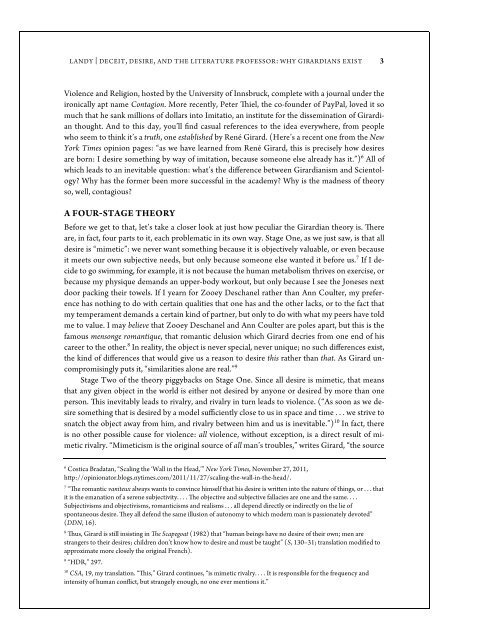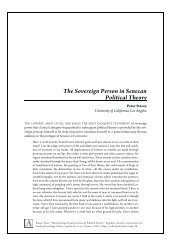Deceit, Desire, and the Literature Professor: Why Girardians Exist
Deceit, Desire, and the Literature Professor: Why Girardians Exist
Deceit, Desire, and the Literature Professor: Why Girardians Exist
Create successful ePaper yourself
Turn your PDF publications into a flip-book with our unique Google optimized e-Paper software.
LANDY | DECEIT, DESIRE, AND THE LITERATURE PROFESSOR: WHY GIRARDIANS EXIST 3<br />
Violence <strong>and</strong> Religion, hosted by <strong>the</strong> University of Innsbruck, complete with a journal under <strong>the</strong><br />
ironically apt name Contagion. More recently, Peter Thiel, <strong>the</strong> co-founder of PayPal, loved it so<br />
much that he sank millions of dollars into Imitatio, an institute for <strong>the</strong> dissemination of Girardian<br />
thought. And to this day, you’ll find casual references to <strong>the</strong> idea everywhere, from people<br />
who seem to think it’s a truth, one established by René Girard. (Here’s a recent one from <strong>the</strong> New<br />
York Times opinion pages: “as we have learned from René Girard, this is precisely how desires<br />
are born: I desire something by way of imitation, because someone else already has it.”) 6 All of<br />
which leads to an inevitable question: what’s <strong>the</strong> difference between Girardianism <strong>and</strong> Scientology?<br />
<strong>Why</strong> has <strong>the</strong> former been more successful in <strong>the</strong> academy? <strong>Why</strong> is <strong>the</strong> madness of <strong>the</strong>ory<br />
so, well, contagious?<br />
A FOUR-STAGE THEORY<br />
Before we get to that, let’s take a closer look at just how peculiar <strong>the</strong> Girardian <strong>the</strong>ory is. There<br />
are, in fact, four parts to it, each problematic in its own way. Stage One, as we just saw, is that all<br />
desire is “mimetic”: we never want something because it is objectively valuable, or even because<br />
it meets our own subjective needs, but only because someone else wanted it before us. 7 If I decide<br />
to go swimming, for example, it is not because <strong>the</strong> human metabolism thrives on exercise, or<br />
because my physique dem<strong>and</strong>s an upper-body workout, but only because I see <strong>the</strong> Joneses next<br />
door packing <strong>the</strong>ir towels. If I yearn for Zooey Deschanel ra<strong>the</strong>r than Ann Coulter, my preference<br />
has nothing to do with certain qualities that one has <strong>and</strong> <strong>the</strong> o<strong>the</strong>r lacks, or to <strong>the</strong> fact that<br />
my temperament dem<strong>and</strong>s a certain kind of partner, but only to do with what my peers have told<br />
me to value. I may believe that Zooey Deschanel <strong>and</strong> Ann Coulter are poles apart, but this is <strong>the</strong><br />
famous mensonge romantique, that romantic delusion which Girard decries from one end of his<br />
career to <strong>the</strong> o<strong>the</strong>r. 8 In reality, <strong>the</strong> object is never special, never unique; no such differences exist,<br />
<strong>the</strong> kind of differences that would give us a reason to desire this ra<strong>the</strong>r than that. As Girard uncompromisingly<br />
puts it, “similarities alone are real.” 9<br />
Stage Two of <strong>the</strong> <strong>the</strong>ory piggybacks on Stage One. Since all desire is mimetic, that means<br />
that any given object in <strong>the</strong> world is ei<strong>the</strong>r not desired by anyone or desired by more than one<br />
person. This inevitably leads to rivalry, <strong>and</strong> rivalry in turn leads to violence. (“As soon as we desire<br />
something that is desired by a model sufficiently close to us in space <strong>and</strong> time . . . we strive to<br />
snatch <strong>the</strong> object away from him, <strong>and</strong> rivalry between him <strong>and</strong> us is inevitable.”) 10 In fact, <strong>the</strong>re<br />
is no o<strong>the</strong>r possible cause for violence: all violence, without exception, is a direct result of mimetic<br />
rivalry. “Mimeticism is <strong>the</strong> original source of all man’s troubles,” writes Girard, “<strong>the</strong> source<br />
6 Costica Bradatan, “Scaling <strong>the</strong> ‘Wall in <strong>the</strong> Head,’” New York Times, November 27, 2011,<br />
http://opinionator.blogs.nytimes.com/2011/11/27/scaling-<strong>the</strong>-wall-in-<strong>the</strong>-head/.<br />
7 “The romantic vaniteux always wants to convince himself that his desire is written into <strong>the</strong> nature of things, or . . . that<br />
it is <strong>the</strong> emanation of a serene subjectivity. . . . The objective <strong>and</strong> subjective fallacies are one <strong>and</strong> <strong>the</strong> same. . . .<br />
Subjectivisms <strong>and</strong> objectivisms, romanticisms <strong>and</strong> realisms . . . all depend directly or indirectly on <strong>the</strong> lie of<br />
spontaneous desire. They all defend <strong>the</strong> same illusion of autonomy to which modern man is passionately devoted”<br />
(DDN, 16).<br />
8 Thus, Girard is still insisting in The Scapegoat (1982) that “human beings have no desire of <strong>the</strong>ir own; men are<br />
strangers to <strong>the</strong>ir desires; children don’t know how to desire <strong>and</strong> must be taught” (S, 130–31; translation modified to<br />
approximate more closely <strong>the</strong> original French).<br />
9 “HDR,” 297.<br />
10 CSA, 19, my translation. “This,” Girard continues, “is mimetic rivalry. . . . It is responsible for <strong>the</strong> frequency <strong>and</strong><br />
intensity of human conflict, but strangely enough, no one ever mentions it.”



